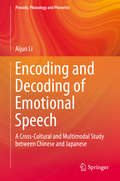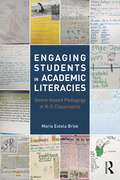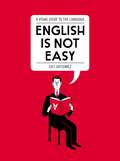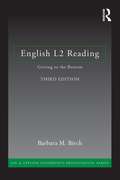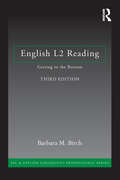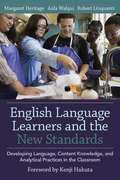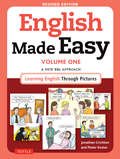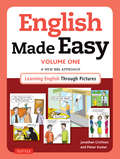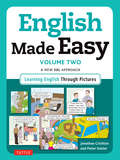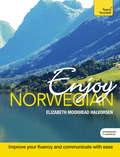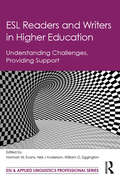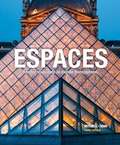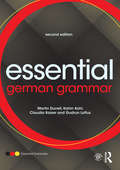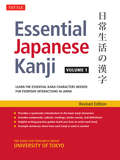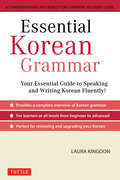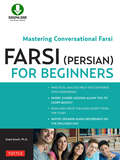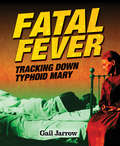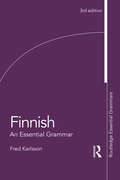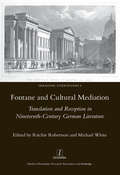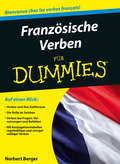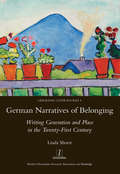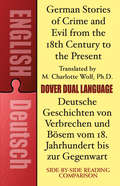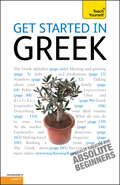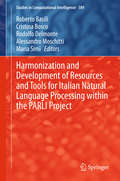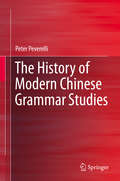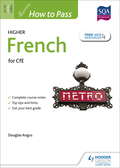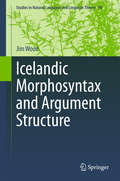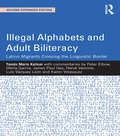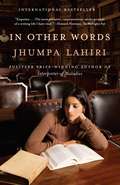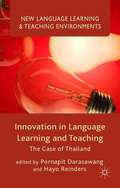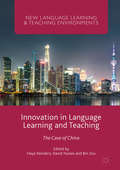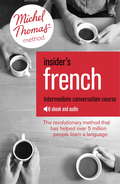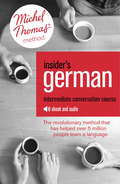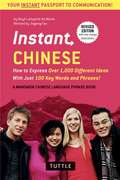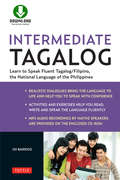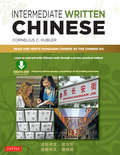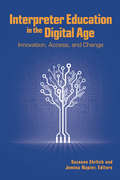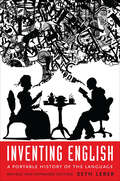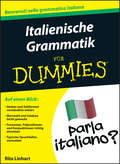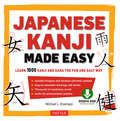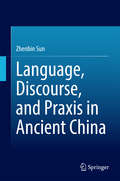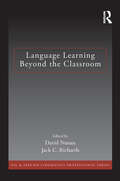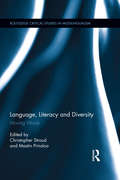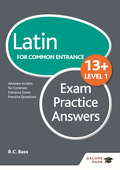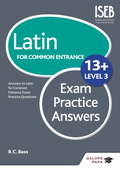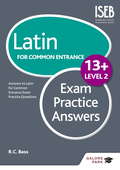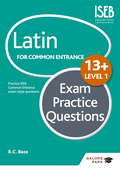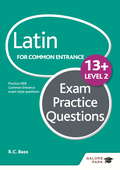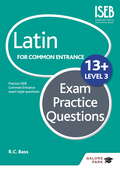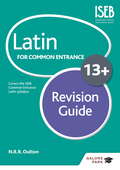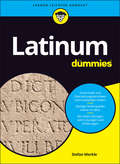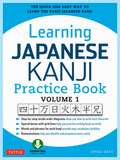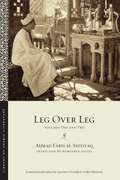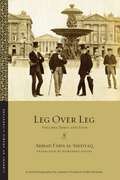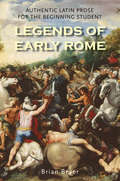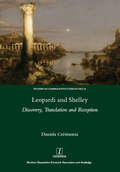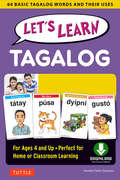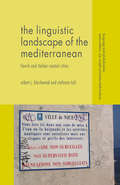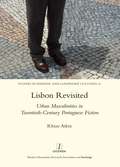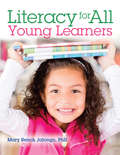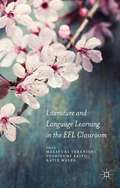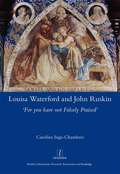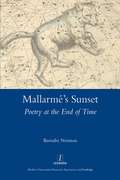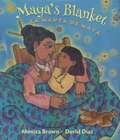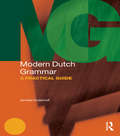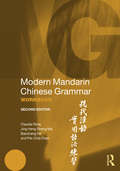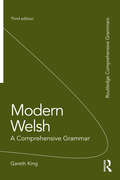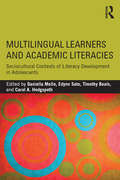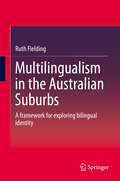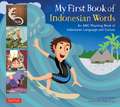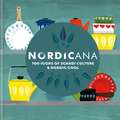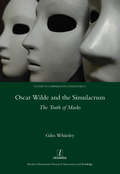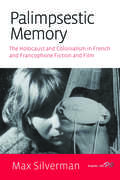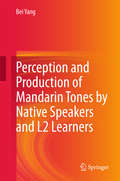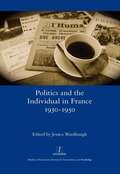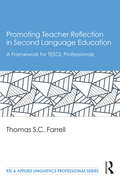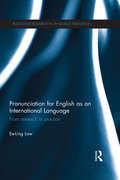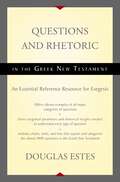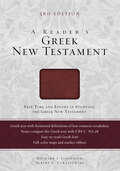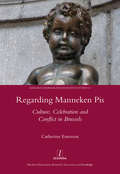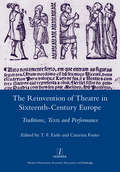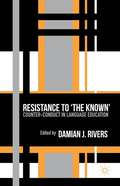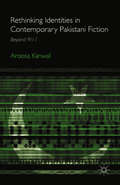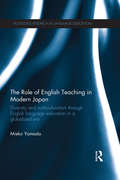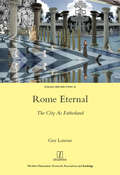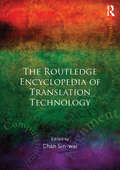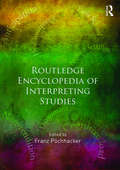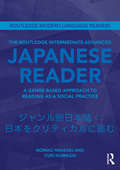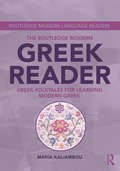- Table View
- List View
Encoding and Decoding of Emotional Speech
by Aijun LiThis book addresses the subject of emotional speech, especially its encoding and decoding process during interactive communication, based on an improved version of Brunswik's Lens Model. The process is shown to be influenced by the speaker's and the listener's linguistic and cultural backgrounds, as well as by the transmission channels used. Through both psycholinguistic and phonetic analysis of emotional multimodality data for two typologically different languages, i. e. , Chinese and Japanese, the book demonstrates and elucidates the mutual and differing decoding and encoding schemes of emotional speech in Chinese and Japanese.
Engaging Students in Academic Literacies: Genre-Based Pedagogy for K-5 Classrooms
by María Estela BriskThe Common Core State Standards require schools to include writing in a variety of genres across the disciplines. Engaging Students in Academic Literacies provides specific information to plan and carry out genre-based writing instruction in English for K-5 students within various content areas. Informed by systemic functional linguistics—a theory of language IN USE in particular ways for particular audiences and social purposes—it guides teachers in developing students’ ability to construct texts using structural and linguistic features of the written language. This approach to teaching writing and academic language is effective in addressing the persistent achievement gap between ELLs and "mainstream" students, especially in the context of current reforms in the U.S. Transforming systemic functional linguistics and genre theory into concrete classroom tools for designing, implementing, and reflecting on instruction and providing essential scaffolding for teachers to build their own knowledge of its essential elements applied to teaching, the text includes strategies for apprenticing students to writing in all genres, features of elementary students’ writing, and examples of practice.
English Is Not Easy: A Visual Guide to the Language
by Luci GutiérrezA cheeky, sophisticated, and strikingly illustrated guide that leaves generic English reference books in the dust When prominent Barcelona-based illustrator Luci Gutiérrez found herself tuning out in English class, she used her love of drawing to help retain what she’d learned. Ditching the kind of bland and useless phrases that fill most English textbooks, Gutiérrez uses whimsical characters, cheeky dialogue, and even insults to bring vocabulary, grammar, and usage topics to life. Nearly forty-seven million people in the United States speak a language other than English at home, and even most native speakers struggle with subtle distinctions, such as when to use “whether” as opposed to “if.” (For example: I wonder whether I should have added a little more poison to his tea.) Already published to wide acclaim abroad, English Is Not Easy is sure to delight grammar mavens and students of English in America.
English L2 Reading: Getting To The Bottom
by Barbara M. BirchEnglish L2 Reading, Third Edition offers teachers research-based insights into bottom-up skills in reading English as a second language and a solid foundation on which to build reading instruction. Core linguistic and psycholinguistic concepts are presented within the context of their application to teaching. The goal is to balance or supplement (not replace) top-down approaches and methodologies with effective low-level options for teaching English reading. The text's pedagogical features-- Questions, Study Guide Questions. Discussion Questions, Spotlight on Teaching sections-- engage readers of the text in moving easily from linguistic details and psycholinguistic data and theory to practical explanations and suggestions for teaching. Two Appendices provide tables that list the graphemes or the phonemes of English.
English L2 Reading: Getting to the Bottom
by Barbara M. BirchEnglish L2 Reading, Third Edition offers teachers research-based insights into bottom-up skills in reading English as a second language and a solid foundation on which to build reading instruction. Core linguistic and psycholinguistic concepts are presented within the context of their application to teaching. The goal is to balance or supplement (not replace) top-down approaches and methodologies with effective low-level options for teaching English reading. The text’s pedagogical features— Questions, Study Guide Questions. Discussion Questions, Spotlight on Teaching sections— engage readers of the text in moving easily from linguistic details and psycholinguistic data and theory to practical explanations and suggestions for teaching. Two Appendices provide tables that list the graphemes or the phonemes of English. Changes in the Third Edition Shift in focus from criticism of whole language methodologies to a more neutral stance —times have changed and the study of lower-level reading strategies is now mainstream Greater focus on linguistic form, along with function and meaning Updated information about reading strategies at each level of the reading process More Spotlight on Teaching sections, one for each chapter New chapter on spelling development
English Language Learners and the New Standards: Developing Language, Content Knowledge, and Analytical Practices in the Classroom
by Margaret Heritage Aída Walqui Robert LinquantiIn English Language Learners and the New Standards, three leading scholars present a clear vision and practical suggestions for helping teachers engage ELL students in simultaneously learning subject-area content, analytical practices, and language. This process requires three important shifts in our perspective on language and language learning—from an individual activity to a socially engaged activity; from a linear process aimed at correctness and fluency, to a developmental process, focused on comprehension and communication; and from a separate area of instruction to an approach that embeds language development in subject-area activities. In English Language Learners and the New Standards, the authors:Clarify the skills and knowledge teachers need to integrate content knowledge and language developmentShow how teachers can integrate formative assessment in ongoing teaching and learningDiscuss key leverage points and stress points in using interim and summative assessments with ELLsProvide classroom vignettes illustrating key practicesFinally, the authors explain the theories and research that underlie their vision and examine the role of policy in shaping pedagogy and assessment for ELL students.
English Made Easy Volume One: 1
by Jonathan Crichton Pieter KosterThis is a fun and user-friendly way to learn EnglishEnglish Made Easy is a breakthrough in English language learning-imaginatively exploiting how pictures and text can work together to create understanding and help learners learn more productively. <P><P> It gives beginner English learners easy access to the vocabulary, grammar and functions of English as it is actually used in a comprehensive range of social situations. Self-guided students and classroom learners alike will be delighted by the way they are helped to progress easily from one unit to the next, using a combination of pictures and text to discover for themselves how English works. The pictorial method used in this book is based on a thorough understanding of language structure and how language is successfully learned. The authors are experienced English language teachers with strong backgrounds in language analysis and language learning.English Made Easy, Volume 1 consists of a total of 20 units arranged in groups of five. The first four units presents language and provide learners the opportunities to practice as they learn. The first page of each unit has a list of all the words and phrases to be learned in that unit, together with pronunciation guide. At the end of each unit, an interesting story which uses the language that has just been learned is presented. The fifth unit in each group contains exercises designed to reinforce the language learned in the first four units.
English Made Easy Volume One: Learning English Through Pictures
by Jonathan Crichton Pieter KosterEnglish Made Easy is a breakthrough in English language learning--imaginatively exploiting how pictures and text can work together to create understanding and help learners learn more productively.<P><P> It gives beginner English learners easy access to the vocabulary, grammar and functions of English as it is actually used in a comprehensive range of social situations. Self-guided students and classroom learners alike will be delighted by the way they are helped to progress easily from one unit to the next, using a combination of pictures and text to discover for themselves how English works. The pictorial method used in this book is based on a thorough understanding of language structure and how language is successfully learned. The authors are experienced English language teachers with strong backgrounds in language analysis and language learning.
English Made Easy Volume Two: 2
by Jonathan Crichton Pieter KosterThis is a fun and user-friendly way to learn EnglishEnglish Made Easy is a breakthrough in English language learning-imaginatively exploiting how pictures and text can work together to create understanding and help learners learn more productively.<P><P> It gives beginner English learners easy access to the vocabulary, grammar and functions of English as it is actually used in a comprehensive range of social situations. Self-guided students and classroom learners alike will be delighted by the way they are helped to progress easily from one unit to the next, using a combination of pictures and text to discover for themselves how English works. The pictorial method used in this book is based on a thorough understanding of language structure and how language is successfully learned. The authors are experienced English language teachers with strong backgrounds in language analysis and language learning.English Made Easy, Volume 2 consists of a total of 20 units arranged in groups of five. The first four units presents language and provide learners the opportunities to practice as they learn. The first page of each unit has a list of all the words and phrases to be learned in that unit, together with pronunciation guide.
Enjoy Norwegian Intermediate to Upper Intermediate Course: Enhanced Edition
by Elizabeth Moorhead Curtiss nee HalvorsenDo you want to have more meaningful conversations in Norwegian? Do you want to feel comfortable in a variety of situations?Based on authentic texts, such as songs, poems, and conversations between native speakers, this course will help you improve and build upon the language you already have so that you develop your skills to a level where you can enjoy communicating in Norwegian. You will be introduced to the more advanced points of Norwegian grammar, as well as more colloquial language, and develop your vocabulary so you can express your opinion on a number of topics, as well as react to other people's opinions.You will enjoy learning about the culture, history and geography of Norway and its influence on the language. What will I achieve by the end of the course?By the end of Enjoy Norwegian you will have increased your capacity to understand the spoken and written language, and furthered your ability to communicate with Norwegian speakers, orally and in writing.Is this course for me?If you already know some Norwegian and want to take it further, this is the course for you. It's perfect for the self-study learner, with a one-to-one tutor, or for the post-beginner classroom.What do I get?A coursebook with over two hours of audio on CD that features:- Ten units that cover more complex situations than your basic tourist scenarios- Carefully levelled and sequenced material - a solid path to build up your knowledge- Authentic texts, such as poems, songs, excerpts and conversations to present the language- Learn through the Discovery Method which helps you notice and retain the language you learn- Learn to learn - tips and advice on becoming a better language learner - Easy to use workbook format This course will take you from a good intermediate level (Level B2 of the Common European Framework / Advanced Low of the ACTFL) and help you progress up to C1 / Advanced High.What else can I use to learn Norwegian?If you require an absolute Beginner course, you can try our Get Started in Norwegian: 9781473612709If you want a comprehensive Beginner to Intermediate course, you should try our Complete Norwegian: 9781444195040Rely on Teach Yourself, trusted by language learners for over 75 years.
ESL Readers and Writers in Higher Education: Understanding Challenges, Providing Support (ESL & Applied Linguistics Professional Series)
by Norman W. Evans Neil J Anderson William G. EggingtonESL Readers and Writers in Higher Education describes the challenges ESL students in U.S. postsecondary institutions face when studying in a second language, and offers suggestions for how teachers, advisors, tutors, and institutions might provide support that meets the reading and writing needs of this very important student population. Because the ESL profession as a whole, including what professionals are doing in the classroom, sits under the umbrella of an institutional response to a language-related challenge, some solutions aimed at helping students achieve optimal proficiency lie outside of the classroom. As such, this book is based on the assertion that language development support is not the sole responsibility of language teachers. Everyone on campuses that hosts ESL students bears some responsibility for these students' language development. Chapters are therefore, intentionally adapted to appeal to a wide variety of readers from classroom teachers, and teachers in training, to admissions officers, academic advisors, and international student advisors.
Espaces: Rendez-vous avec le monde francophone
by James G. Mitchell Cheryl TanoNIMAC-sourced textbook
El español de los Estados Unidos
by Anna María Escobar Kim PotowskiHow long has Spanish been spoken in the US and how many people speak it today? Is Spanish being passed down through generations? What role does Spanish play in US Latino identity? Analysing and synthesising data from a wide variety of sources, Escobar and Potowski explore these questions and more in this up-to-date textbook for students of Spanish language, linguistics, bilingualism, sociolinguistics, culture, and history. • Over 150 exercises help students engage with the linguistic characteristics of Spanish, Spanish-dialect contact, bilingualism, and Spanish communities in the US • Exercises and examples refer students to external, online sources so they can experience Spanish through a range of media • Concepts are clearly defined with detailed examples for readers who may not have a background in linguistics • Misconceptions about Spanish varieties and Latino communities are addressed, ensuring readers will emerge with a clear understanding of how Latino communities vary linguistically and socioculturally. Linguistic concepts are clearly defined, and more complex concepts include detailed examples and exercises. Each chapter contains exercises which help readers to understand and reflect on new material. Chapter exercises direct readers to online resources so they can experience authentic examples.
Essential German Grammar (Essential Language Grammars)
by Martin Durrell Katrin Kohl Gudrun Loftus Claudia KaiserEssential German Grammar is a student-friendly grammar and workbook designed to give learners a firm foundation on which to build a real understanding of both spoken and written German. The reference grammar section offers clear explanations of key grammar points while a separate exercise section gives students the opportunity to test themselves and put into practice what they have learned. This new edition has been revised and updated throughout. Explanations, tables and exercises have been improved and a number of the authentic texts and illustrations have been replaced by new material. Key features of this second edition include: User-friendly layout with updated 2 colour design, engaging illustrations and visually appealing tables throughout to aid the learning process Clear and accessible explanations with memorable examples informed by the latest research on the German language and presented in accordance with current teaching methodology Helpful parallels between English and German provided where relevant End-of-chapter extracts taken from contemporary journalistic or authentic literary sources, illustrating grammar in context, with model translations provided at the back of the book Material to enable better strategic learning and understanding, including a Why Grammar?—FAQ section, a glossary of grammatical terms in both English and German and a complete answer key to exercises Created especially for the new edition, a companion website at www.routledge.com/cw/kaiser offering a wealth of additional materials, including interactive exercises, quizzes and flashcards to test student understanding, downloadable PDF sheets for classroom use, PowerPoint slides for instructors and audio recordings illustrating the sounds of spoken German. Written by highly experienced lecturers in the field, Essential German Grammar is an invaluable resource for intermediate and advanced students of German (CEFR levels A2 to B2, ACTFL Novice High to Intermediate High). It is designed to function equally as a free-standing grammar or as a foundation grammar for Hammer’s German Grammar and Usage and is suitable for both classroom use and self-study.
Essential Japanese Kanji Volume 1
by Kanji Text University of TokyoMemorize tricky Japanese kanji with ease!Since its publication in 1993, this beginner Japanese workbook and textbook has been a hit with teachers and students for learning basic Japanese kanji characters. Speak, read and write Japanese with this newly revised edition that has been updated and expanded by members of the Kanji Text Research Group at the prestigious Tokyo University.Essential Japanese Kanji Volume 1 presents the 250 kanji characters that are most frequently found in many places in Japan, including: Street signs Restaurant menus Subway ticket machines ATMsStroke order diagrams and writing practice squares present every kanji systematically alongside its various meanings, readings, vocabulary compounds and derivations. Extensive practice exercises and self-graded quizzes (with answer keys at the back) help you improve your skill at recognizing and using the kanji.In addition to the practical focus of learning the kanji in the context of actual situations, each chapter includes Advanced Placement (AP)-type exam questions mirroring the format of the College Board's Japanese Language and Culture examination. The captivating introduction explains the origins of the kanji and the Japanese kana phonetic alphabets. Appendices list the kanji in two ways-according to pronunciations and radicals-and a glossary of common vocabulary compounds.
Essential Korean Grammar
by Laura KingdonDo you want your Korean language skills to shine? Then Essential Korean Grammar offers exactly what you need to finally understand and express which grammar option is best. Having a solid understanding of grammar is essential to effectively learn Korean. Essential Korean Grammar gives you excellent examples that lay out the best grammar options for communicating, and when to use each option. The grammar items are cleverly rated so you can determine what's most useful for you to study, based on your Korean knowledge level and your plans. There is a star rating system, from 5 stars ("critical"; with these under your belt you can communicate almost everything you need to say) to 1 star (don't worry about this unless there's some reason you need to know it—for example, the TOPIK exam). Essential Korean Grammar is a toolbox to help you form correct and natural-sounding sentences, and determine which grammar you need for reading or writing Korean. It details: How to combine grammar points with each type of word. How it is similar to and different from related grammar points. Commonly used expressions. Things for learners to watch out for. The example sentences for each grammar point use simple vocabulary that even a beginner will know. A perfect supplement to any Korean language textbook!
Farsi (Persian) for Beginners: Mastering Conversational Farsi
by Saeid AtoofiPerfect for self-studiers or students, this Farsi language education book takes a user-friendly and clear approach.<P><P>Farsi is the language of Persia (present-day Iran)--the mellifluous mother tongue of famed 13th-century poet Rumi, whose works are still among the best-selling poems in America today. Farsi for Beginners is a complete language course by experienced teacher Dr. Saeid Atoofi which can help you to speak the language and understand this beautiful work of art in its original, as well as open doors to the Persian culture that is so popular in America today.Whether for pleasure, travel or business, language learners will find these lessons clear and easy to follow. By the end of this course, you'll be able to understand short sentences, express your basic needs, and read and write the 32-letter Farsi alphabet.Farsi for Beginners contains the following essential features: Native-speaker audio recordings help you to pronounce Farsi accurately. Dialogues and stories about a family traveling to contemporary Iran. Idioms, sayings and poems introducing you to the cultures in which Farsi is used. Extensive exercises with answer keys to guide your learning process. Photos and insider cultural tips teach you about Persian culture.Nearly one million Iranian-Americans live in the U.S. today, and a part of Los Angeles is referred to as "Tehrangeles". Farsi is also considered a "critically needed" language by the U.S. government. Learning Persian with Farsi for Beginners and its accompanying audio disc, can open opportunities for travel, for work, or simply to meet new people and understand their lives in a totally new way.
Fatal Fever: Tracking Down Typhoid Mary
by Gail JarrowIn the early 1900s, when typhoid fever was killing tens of thousands of Americans each year, Mary Mallon was employed as a cook by several well-to-do New York families. <P><P>When some members of these households developed the disease, suspicion turned to Mary. Did she have anything to do with the spread of the deadly bacteria? <P>Here is the gripping, true story of Typhoid Mary; the epidemiologist who discovered her trail of infection; and the health department that decided her fate. Fatal Fever will keep readers on the edges of their seats as they wonder what will happen next. <P>Award-winning science and history writer Gail Jarrow brings her expertise to this engrossing medical mystery. Extensive back matter includes a glossary, a timeline, and a list of well-known typhoid sufferers and victims.
Finnish: A Comprehensive Grammar (Routledge Essential Grammars)
by Fred KarlssonThis thoroughly revised third edition of Finnish: An Essential Grammar is grounded in fundamental insights of modern linguistics and incorporates some of the latest achievements in the description of written and spoken Finnish. It gives a systematic account of the structures of the written language and offers increased attention to the key characteristics of present-day colloquial Finnish. No prior knowledge is assumed on the part of the reader and grammatical rules are clearly explained without jargon. Features of this new edition include: • pronunciation guide, including the tendencies in present-day colloquial Finnish • thorough descriptions of morphology (word structure) and syntax (sentence structure) • clear rules and an abundance of concrete examples, from both written and colloquial Finnish • updated vocabulary in the examples • an effective new scheme for detecting the morphological structure of any word form • subject index. This is the ideal reference source both for those studying Finnish independently and for students in schools, colleges, universities and adult classes of all types.
Fontaine and Cultural Mediation: Translation and Reception in Nineteenth-Century German Literature
by Robertson RitchieIn the mid-1880s, the Realist author and Anglophile Theodor Fontane observed: �nowhere is so much translation done as in Germany.� Characterizing Germany as a special locus of literary translation and reception, Fontane contests a prejudice which has since become a significant problem for nineteenth-century German studies, namely the frequent assessment of the epoch as narrowly national. The present collection of essays by thirteen eminent literary scholars and historians is intended to correct this prejudice: it demonstrates that literary life and production in the nineteenth century were governed by complex networks of intercultural exchange, influence and translation, and it does justice to this complexity through its range of complementary critical approaches, focussing on Fontane, Anglo-German relations, translation, and European reception. In so doing, this book not only offers a nuanced appreciation of literary production and reception in the nineteenth century, but also demonstrates the continued relevance of that period for Germanists today.
Französische Verben für Dummies (Für Dummies)
by Norbert BergerVom Unmöglichen und Möglichen bis zum Blick in die Zukunft Grammatik ist nicht jedermanns Sache und die Konjugation der französischen Verben macht es einem auch nicht immer leicht. Norbert Berger kennt die Nöte der Lernenden und die Tücken der französischen Verben bestens. Leicht verständlich, mit einer Prise Humor und anhand vieler Beispiele erklärt er alles über die verschiedenen Zeiten, das Konditional, den Subjonctif, den Imperativ, Fragestellung und Verneinung. Am Ende eines jeden Kapitels gibt es Übungen, die das Gelernte noch einmal wiederholen. Konjugationstabellen der wichtigsten französischen regelmäßigen und unregelmäßigen Verben bieten Ihnen einen guten Überblick. So sind Sie für den nächsten Test bestens gerüstet.
German Narratives of Belonging: Writing Generation and Place in the Twenty-First Century
by Linda ShorttSince unification, German culture has experienced a boom in discourses on generation, family and place. Linda Shortt reads this as symptomatic of a wider quest for belonging that mobilises attachment to counter the effects of post-modern deterritorialisation and globalisation. Investigating twenty-first century narratives of belonging by Reinhard Jirgl, Christoph Hein, Angelika Overath, Florian Illies, Juli Zeh, Stephan Wackwitz, Uwe Timm and Peter Schneider, Shortt examines how the desire to belong is repeatedly unsettled by disturbances of lineage and tradition. In this way, she combines an analysis of supermodernity with an enquiry into German memory contests on the National Socialist era, 1968 and 1989 that continue to shape identity in the Berlin Republic. Exploring a spectrum of narratives that range from agitated disavowals of place to romances of belonging, this study illuminates the topography of belonging in contemporary Germany.
German Stories of Crime and Evil from the 18th Century to the Present / Deutsche Geschichten von Verbrechen und Bösem vom 18. Jahrhundert bis zur Gegenwart: A Dual-Language Book (Dover Dual Language German)
by Prof. M. Charlotte WolfIdeal for students of German as well as crime story enthusiasts, this dual-language edition contains ten short stories. Selections range from eighteenth- and nineteenth-century classics by Friedrich Schiller ("Der Verbrecher aus verlorener Ehre"/"The Criminal of Lost Honor") and Willibald Alexis ("Das Gelöbnis der drei Diebe"/"The Pledge of the Three Thieves") to tales by such popular contemporary authors as Iris Klockmann ("Der Kuss des Todes"/"The Kiss of Death") and Karin Holz ("Der letzte Stich"/"The Last Trick").Appropriate for intermediate-level students of German, this volume is equally suited to classroom use and independent study. New English translations appear on pages facing the original German text. The editor provides an overview of German crime fiction in addition to concise introductions to each story.
Get Started in Beginner's Greek: Teach Yourself
by Aristarhos MatsukasThis product is most effective when used in conjunction with the corresponding audio support.- You can purchase the book and audio support as a pack (ISBN: 9781444101621)- The audio support is also sold separately (ISBN: 9781444101546)(copy and paste the ISBN number into the search bar to find these products)Are you looking for a course in Greek written for the absolute beginner who has no experience of learning a foreign language? Get Started in Greek will give you the confidence to communicate in Greek. Now fully updated to make your language learning experience fun and interactive. You can still rely on the benefits of a top language teacher and our years of teaching experience, but now with added learning features within the course and online. The emphasis of the course is placed on communication, rather than grammar, and all the teaching is in English, so that you will quickly and effortlessly get started in Greek. By the end of this course, you will be at Level B1 of the Common European Framework for Languages: can deal with most situations likely to arise whilst travelling in an area where the language is spoken. Learn effortlessly with new, easy-to-read page design and interactive features: NOT GOT MUCH TIME?Short introductions to key principles to get you started.AUTHOR INSIGHTSLots of instant help with common problems and quick tips for success, based on the author's many years of experience.USEFUL VOCABULARYEasy to find and learn, to build a solid foundation for speaking.DIALOGUESRead and listen to everyday dialogues to help you speak and understand fast.PRONUNCIATIONDon't sound like a tourist! Perfect your pronunciation before you go.TEST YOURSELFTests in the book and online to keep track of your progress.
Harmonization and Development of Resources and Tools for Italian Natural Language Processing within the PARLI Project
by Roberto Basili Cristina Bosco Rodolfo Delmonte Alessandro Moschitti Maria SimiThe papers collected in this volume are selected as a sample of the progress in Natural Language Processing (NLP) performed within the Italian NLP community and especially attested by the PARLI project. PARLI (Portale per l'Accesso alle Risorse in Lingua Italiana) is a project partially funded by the Ministero Italiano per l'Università e la Ricerca (PRIN 2008) from 2008 to 2012 for monitoring and fostering the harmonic growth and coordination of the activities of Italian NLP. It was proposed by various teams of researchers working in Italian universities and research institutions. According to the spirit of the PARLI project, most of the resources and tools created within the project and here described are freely distributed and they did not terminate their life at the end of the project itself, hoping they could be a key factor in future development of computational linguistics.
The History of Modern Chinese Grammar Studies
by Peter PeverelliThis book discusses the way Chinese scholars developed a national grammar. Chinese didn't develop grammar until China's contact with Western grammar books in the 19th Century. The first indigenous grammar was published in 1889. It included some traditional notions, but mainly imitated European grammar. It was followed by a number of other similar works. To move away from this imitation, a group of grammarians started to look into the Chinese tradition of commenting on classics. This led to a variety of alternative grammars. After the war, Western linguistics started to gain influence in China. With the establishment of the PRC in 1949, efforts began to have a standard grammar adopted nationwide. The first attempt at such a grammar was published in 1956. This book spans the period 1898 - 1956. This book combines historiography and linguistics to distinguish different periods in the timespan covered. It shows how the development of a national grammar cannot be studied separately from language policies and discussions on the national language. The description of each period includes a general introduction of the relevant events in that period and a treatment of the major works of grammar.
How to Pass Higher French for CfE
by Douglas AngusGet your best grade with the SQA endorsed guide to Higher French for CfE.This book contains all the advice and support you need to revise successfully for your Higher (for CfE) exam. It combines an overview of the course syllabus with advice from a top expert on how to improve exam performance, so you have the best chance of success.- Refresh your knowledge with complete course notes- Prepare for the exam with top tips and hints on revision techniques- Get your best grade with advice on how to gain those vital extra marksYou can download free audio files for this book!Visit www.hoddereducation.co.uk/updatesandextras
Icelandic Morphosyntax and Argument Structure
by Jim WoodThis book provides a detailed study of Icelandic argument structure alternations within a syntactic theory of argument structure. Building on recent theorizing within the Minimalist Program and Distributed Morphology, the author proposes that much of what is traditionally attributed to syntax should be relegated to the interfaces, and adapts the late insertion theory of morphology to semantics. The resulting system forms sound-meaning pairs by generating hierarchical structures that can be translated into morphological representations, on the one hand, and semantic representations, on the other. The syntactic primitives, however, underdetermine both morphophonology and semantics. Without appealing to special stipulations, the theory derives constraints on the external argument of causative-alternation verbs, interpretive restrictions on nominative objects, and the optionally agentive interpretation of verbs denoting self-directed motion.
Ideas in Context: Italian Renaissance Humanism in the Mirror
by Patrick BakerThis important study takes a new approach to understanding Italian Renaissance humanism, based not on scholarly paradigms or philosophical concepts but on a neglected yet indispensable perspective: the humanists' understanding of themselves. Through a series of close textual studies, Patrick Baker excavates what humanists thought was important about humanism, how they viewed their own history, what goals they enunciated, what triumphs they celebrated - in short, he attempts to reconstruct humanist identity. What emerges is a small, coherent community dedicated primarily not to political ideology, a philosophy of man, an educational ethos, or moral improvement, but rather to the pursuit of classical Latin eloquence. Grasping the significance this stylistic ideal had for the humanists is essential to understanding both their sense of themselves and the importance they and others attached to their movement. For eloquence was no mere aesthetic affair but rather appeared to them as the guarantor of civilisation itself.
Illegal Alphabets and Adult Biliteracy: Latino Migrants Crossing the Linguistic Border, Expanded Edition
by Tomás Mario KalmarHow do "illegal aliens" chart the speech sounds of colloquial English? This book is timeless in offering an unusually direct entry into how a group of Mexican fruit pickers analyze their first encounter with local American speech in a tiny rural Midwestern community in the United States. Readers see close up how intelligently migrant workers help each other use what they already know—the alphabetic principle of one letter, one sound—to teach each other, from scratch, at the very first contact, a language which none of them can speak. They see how and why the strategies adult immigrants actually use in order to cope with English in the real world seem to have little in common with those used in publicly funded bilingual and ESL classrooms. What’s new in this expanded edition of Tomás Mario Kalmar’s landmark Illegal Alphabets and Adult Biliteracy are in-depth commentaries from six distinguished scholars—Peter Elbow, Ofelia García, James Paul Gee, Hervé Varenne, Luis Vázquez León, Karen Velasquez—who bring to it their own personal, professional, and (multi)disciplinary viewpoints.
In Other Words
by Ann Goldstein Jhumpa Lahiri<P>From the Pulitzer Prize winner, a surprising, powerful and eloquent non-fiction debut.In Other Words is at heart a love story--of a long and sometimes difficult courtship, and a passion that verges on obsession: that of a writer for another language. <P>For Jhumpa Lahiri, that love was for Italian, which first captivated and capsized her during a trip to Florence after college. And although Lahiri studied Italian for many years afterward, true mastery had always eluded her. So in 2012, seeking full immersion, she decided to move to Rome with her family, for "a trial by fire, a sort of baptism" into a new language and world. <P> In Rome, Lahiri began to read, and to write--initially in her journal--solely in Italian. In Other Words, an autobiographical work written in Italian, investigates the process of learning to express oneself in another language, and describes the journey of a writer seeking a new voice. Presented in a dual-language format, it is a book about exile, linguistic and otherwise, written with an intensity and clarity not seen since Nabokov. <P>A startling act of self-reflection and a provocative exploration of belonging and reinvention. Translated from the Italian by Ann Goldstein. <P><b>A New York Times Bestseller</b>
The Indo-European Controversy
by Pereltsvaig, Asya and Lewis, Martin W. Asya Pereltsvaig Martin W. LewisOver the past decade, a group of prolific and innovative evolutionary biologists has sought to reinvent historical linguistics through the use of phylogenetic and phylogeographical analysis, treating cognates like genes and conceptualizing the spread of languages in terms of the diffusion of viruses. Using these techniques, researchers claim to have located the origin of the Indo-European language family in Neolithic Anatolia, challenging the near-consensus view that it emerged in the grasslands north of the Black Sea thousands of years later. But despite its widespread celebration in the global media, this new approach fails to withstand scrutiny. As languages do not evolve like biological species and do not spread like viruses, the model produces incoherent results, contradicted by the empirical record at every turn. This book asserts that the origin and spread of languages must be examined primarily through the time-tested techniques of linguistic analysis, rather than those of evolutionary biology.
Innovation in Language Learning and Teaching
by Pornapit Darasawang Hayo ReindersHow does innovation in language teaching come about? This book covers the ways in which new developments in areas of language teaching practice, such policy-making, planning, methodology and the use of educational technology spread globablly and are adopted, rejected or adapted locally. By looking at the drivers, stakeholders, obstacles and affordances in one specific context – Thailand in the case of this book - it is possible to gain a deeper insight into the ways in which change processes occur. This will help anyone involved in language development, from curriculum reform to materials development, and from programme evaluation to the setting of assessment standards. The chapters in this book cover all aspects of language education in Thailand, from the primary to tertiary levels in both private and public education, as well as innovations at local, regional and national levels. The book will be of particular interest to those involved in managing change in language education that attempts to mediate between global trends and local priorities.
Innovation in Language Learning and Teaching
by Hayo Reinders David Nunan Bin ZouThis book investigates the ways in which new developments in areas of language teaching practice, such policymaking, planning, methodology and the use of educational technology spread globally and are adopted, rejected or adapted locally.
Insider's French (Learn French with the Michel Thomas Method): Enhanced Ebook
by Akshay Bakaya Michel ThomasDo you want to be able to express yourself in French with confidence and fluency?Insider's French offers a genuine perspective on Francophone culture, opinions and language use so that you can speak confidently on topical issues that are key to the French speaker today.This intermediate French conversation course, devised for all intermediate-level learners or those following on from Total or Perfect French, will advance your overall fluency, listening comprehension and conversation skills, expand your vocabulary and improve your grammar. Through authentic, lively conversations around engaging topics, and the unique Michel Thomas Method for learning, this course focuses on the colloquial language and conversation strategies used by native French speakers so that you can fit in and communicate more naturally.Michel Thomas, the preeminent language teacher, always said that learners start by mastering basic linguist structures (as in his Total and Perfect courses), which provide the bare walls of the house, but that that it was up to us, the learner, to decorate it in our own personal way. Insider's German reflects Michel Thomas's 'Phase 2' courses that he and his team offered at his New York language school, allowing increased vocabulary, improved speaking, comprehension and reading and writing skills - the tools with which to decorate their houses.Insider's French includes:· Twenty authentic conversations around a comprehensive range of subjects that reflect contemporary French culture· Language plus: conversation strategies, pronunciation and intonation to help learners express themselves naturally· Listening and speaking practice to help learners progress to the next level· Cultural insights into the unspoken rules of the language This ebook includes 10 chapters with integrated audio conversations.Why is the Michel Thomas Method so successful?The Michel Thomas Method draws on the principles of instructional psychology. Knowledge is structured and organised for the student so that you assimilate the language easily and don't forget it. The method deconstructs the language into building blocks that are introduced sequentially in such a way that the learner creates his/her response and moves on to ever-more-complex sentences. Michel said: I will dissect everything into small parts and reassemble it in such a way that one will understand everything step by step.He was also very clear about his ground rules: no memorisation, no drills, no homework; relax and leave off the anxiety normally associated with language learning.
Insider's German Intermediate Conversation Course (Learn German with the Michel Thomas Method): Enhanced Ebook
by Marion O'Dowd Michel ThomasDo you want to be able to express yourself in German with confidence and fluency?Insider's German offers a local perspective on German culture, opinions and language use so that you can speak confidently on today's most important and relevant topics. This intermediate German conversation course, devised for all intermediate-level learners or those following on from Total or Perfect German, will advance your overall fluency, listening comprehension and conversation skills, expand your vocabulary and improve your grammar. Through authentic, lively conversations around engaging topics, and the unique Michel Thomas Method for learning, this course focuses on the colloquial language and conversation strategies used by native German speakers so that you can fit in and communicate more naturally.Michel Thomas, the preeminent language teacher, always said that learners start by mastering basic linguist structures (as in his Total and Perfect courses), which provide the bare walls of the house, but that it was up to us, the learner, to decorate it in our own personal way. Insider's German reflects Michel Thomas's 'Phase 2' courses that he and his team offered at his New York language school, allowing increased vocabulary, improved speaking, comprehension and reading and writing skills - the tools with which to decorate their houses.Insider's German includes:· Twenty authentic conversations around a comprehensive range of subjects that reflect contemporary German culture· Language plus: conversation strategies, pronunciation and intonation to help learners express themselves naturally· Listening and speaking practice to help learners progress to the next level· Cultural insights into the unspoken rules of the language This ebook includes 10 chapters with integrated audio conversations.Why is the Michel Thomas Method so successful?The Michel Thomas Method draws on the principles of instructional psychology. Knowledge is structured and organised for the student so that you assimilate the language easily and don't forget it. The method deconstructs the language into building blocks that are introduced sequentially in such a way that the learner creates his/her response and moves on to ever-more-complex sentences. Michel said: I will dissect everything into small parts and reassemble it in such a way that one will understand everything step by step.He was also very clear about his ground rules: no memorisation, no drills, no homework; relax and leave off the anxiety normally associated with language learning.
Instant Chinese: How to Express Over 1,000 Different Ideas with Just 100 Key Words and Phrases! (A Mandarin Chinese Language Phrasebook
by Jiageng Fan Boye Lafayette De MenteIt's amazing how 100 key words and phrases provide instant communication!Do you want to speak simple Mandarin Chinese but are too busy to study it? Are you visiting China for a short time and want a Mandarin phrase book to help you communicate in the Chinese language? If so, this Mandarin phrasebook is for you. It's tiny 0.4 x 4.1 x 5.9 inches size makes it incredibly convenient to travel with but without losing the most essential content for communication. This new, expanded edition contains 15% more content, fun manga-style illustrations, and additional information on which destinations, personalities and trends are hot in China right now!The idea of Instant Chinese is simple--learn 100 words and phrases and say 1,000 things. The trick is knowing which 100 words to learn, but the author Boye Lafayette De Mente has solved the problem, choosing only those words you'll hear again and again. Even with a vocabulary this small, you'll be surprised how quickly and fluently you too can communicate in Mandarin Chinese. Words are repeated in different combinations, building familiarity without effort. All phrases are given in both simplified Chinese characters and standard Hanoi Pinyin romanization. A brief guide to pronunciation allows the user to say the phrases correctly. An English-Chinese glossary makes looking up a word or phrase simple and quick. Here's a sample of what you'll be able to do with this chinese phasebook: Meet people. Go shopping. Ask directions. Ride the subway. Order food and drinks. And much more.
Intermediate Tagalog
by Joi BarriosAt last, a way to improve your Tagalog! Written by Joi Barrios as the continuation of her best-sellingTagalog for Beginners book,Intermediate Tagalog is the first intermediate-level book designed specifically for people who already speak or understand some basic Tagalog and now wish to achieve greater fluency in speaking, reading and writing standard Filipino—the national language of the Philippines. The carefully-constructed lessons in this book point out common grammatical errors that English speakers make when speaking Tagalog, and present "real-life" conversations demonstrating how the language is spoken in Manila today. Extensive cultural notes are provided, along with exercises and activities that introduce the use of the Tagalog language in a wide range of everyday situations. The 20 lessons give you all the basic skills needed to speak Tagalog fluently:paglalarawan (the ability to describe people, places and feelings);pagsasalaysay (the ability to tell a story—whether a news story, a folktale, or an anecdote);paglalahad (how to explain something—for example, a custom or tradition, or how to cook a dish); andpangangatuwiran (reasoning and abstract thinking). Each lesson is carefully structured in six key parts: A "real-life" dialogue providing valuable conversational skills. Avocabulary list to expand your familiarity with common, everyday Tagalog words and expressions. A grammar review section (for example, on the correct uses of affixes in various sentence constructions). Insightful cultural notes presenting aspects of the Philippines that may seem "odd" to outsiders, to explain how Filipino culture shapes the way people speak. A reading passage from a story or newspaper article, with comprehension questions. A writing exercise designed to teach a specific writing skill. UsingIntermediate Tagalog, you'll be able to talk about yourself, your family and your daily experiences using grammatically correct sentences and a native-speaker level vocabulary.
Intermediate Written Chinese
by Cornelius C. KublerThis is an intermediate-level course in written Chinese that employs a revolutionary new method designed to have you quickly reading and writing simple, connected Chinese sentences. The Basic Chinese and Intermediate Chinese books provide separate but integrated "tracks" to help you learn to read, write and speak Chinese efficiently at your own pace. Some students and teachers wish to emphasize speaking ability first, whereas others wish to focus on learning to read and write Chinese at the same time. Intermediate Written Chinese allows you the flexibility to learn the spoken language and the written Chinese at your own pace. Learn to use 288 high frequency characters, and over 700 common words written with them. Carefully designed to have you quickly reading and writing connected Chinese sentences. Both simplified and traditional characters are taught throughout; you may choose to learn one or both. Features a variety of fonts in both typeset and handwritten styles, to prepare you to use Chinese in many different contexts—from reading signs and newspapers, to computers and mobile phone texts. Hours of native-speaker recordings and practice sheets, plus printable flash cards on the enclosed CD-ROM. The accompanying CD-ROM includes: Over 6 hours of audio by several native Mandarin speakers. Recordings of all reading selection. Additional characters. New vocabulary. Available separately, Intermediate Written Chinese Practice Essentials is the companion workbook for Intermediate Written Chinese. This practical guide includes a broad range of drills and exercises designed to dramatically enhance your proficiency in reading and writing Chinese. While designed for use with the companion textbook, it can be used together with any Chinese textbook or teaching program to hone your Chinese reading and writing language skills.
Interpreter Education in the Digital Age: Innovation, Access, and Change
by Jemina Napier Suzanne EhrlichThis collection brings together innovative research and approaches for blended learning using digital technology in interpreter education for signed and spoken languages. Volume editors Suzanne Ehrlich and Jemina Napier call upon the expertise of 21 experts, including themselves, to report on the current technology used to provide digital enhancements to interpreter education in Australia, New Zealand, Brazil, Belgium, the United Kingdom, and the United States. Divided into three parts, Innovation, Change, and Community Engagement, this study focuses on the technology itself, rather than how technology enhances curriculum, delivery, or resources. Initiatives described in this collection range from the implementation of on-demand interpreting using iPad technology to create personalized, small-group, multidimensional models suited to digital media for 160 languages; introducing students to interpreting in a 3D world through an IVY virtual environment; applying gaming principles to interpreter education; assessing the amenability of the digital pen in the hybrid mode of interpreting; developing multimedia content for both open access and structured interpreter education environments; to preparing interpreting students for interactions in social media forums, and more. Interpreter Education in the Digital Age provides a context for the application of technologies in interpreter education from an international viewpoint across languages and modalities.
Inventing English: A Portable History of the Language
by Seth LererA history of English from the age of Beowulf to the rap of Eminem, &“written with real authority, enthusiasm and love for our unruly and exquisite language&” (The Washington Post). Many have written about the evolution of grammar, pronunciation, and vocabulary, but only Seth Lerer situates these developments within the larger history of English, America, and literature. This edition of his &“remarkable linguistic investigation&” (Booklist) features a new chapter on the influence of biblical translation and an epilogue on the relationship of English speech to writing. A unique blend of historical and personal narrative, both &“erudite and accessible&” (The Globe and Mail), Inventing English is the surprising tale of a language that is as dynamic as the people to whom it belongs. &“Lerer is not just a scholar; he's also a fan of English—his passion is evident on every page of this examination of how our language came to sound—and look—as it does and how words came to have their current meanings…the book percolates with creative energy and will please anyone intrigued by how our richly variegated language came to be.&”—Publishers Weekly (starred review)
Italienische Grammatik für Dummies (Für Dummies)
by Rita LinhartSteht der nächste Test an, haben Sie italienische Kollegen, mit denen Sie sich austauschen wollen, oder möchten Sie in Ihrem Italienurlaub mehr als einfach nur "Grazie" sagen können? Grammatik ist nicht jedermanns Sache und die italienische Grammatik macht es einem auch nicht immer leicht. Rita Linhart kennt die Nöte der Lernenden und die Fallen der italienischen Grammatik, in die sie häufig hineintappen. Leicht verständlich, mit einer Prise Humor und anhand vieler Beispiele und Informationen zu Land und Leuten erklärt sie alles über Artikel und Pronomen, Adjektive und Adverbien, Fragestellung und Verneinung, die Zeiten und die Satzstellung. Am Ende eines jeden Kapitels gibt es Übungen, die das Gelernte noch einmal wiederholen. Tabellen der wichtigsten italienischen Verben bieten ganz Eiligen alle Konjugationen auf einen Blick. So sind Sie für den nächsten Test gerüstet, können mit Ihren italienischen Kollegen über zukünftige Projekte sprechen oder einfach nur unbeschwert im Italienurlaub parlieren.
Japanese
by Yoko HasegawaThis is an extensive beginning level Japanese textbook and language learning program. Elementary Japanese is designed for students who are just beginning their study of the Japanese language at the first#8211:year college level or on their own. The author and contributors have created a highly structured approach to learning Japanese that is based on learning the fundamental patters and constructions of the language as well as the writing system including basic kanji. Systematic grammatical explanations are provided in enough detail for this book to be used as a referencework as well as an introductory textbook. The accompanying MP3 audio CD is a great way to learn Japanese and ensures correct pronunciation and helps to build listening comprehension. After completing this course, you will be able to: - Describe yourself, your family and your friends. - Talk about daily events using basic vocabulary and grammatical constructions. - Understand conversations on these topics as well as classroom activities. - Read Japanese articles and write short and simple compositions and letters.
Japanese Kanji Made Easy: Learn 1,000 Kanji and Kana the Fun and Easy Way
by Michael L. KluemperMake character memorization a breeze with Japanese Kanji Made Easy! <P><P> Learning the fundamental kanji characters used to write Japanese can be challenging, but this book is designed to speed up learning by presenting the 1,000 most common characters using a mnemonic approach. In a fun and accessible way to learn Japanese, each kanji is associated with memorable visual and verbal clues. For example, the Japanese character for person is superimposed over a sketch of a smiling man. The visual clue is "a person standing on two legs". By seeing the distinctive shape of the kanji, learners create a mental image of its meaning.As well, each character is presented as part of a group of characters which share similar traits. These groups use common root symbols known as radicals; they are also categorized by themes such as colors, numbers, animals, or body parts. Pronunciations, meanings and common vocabulary compounds are provided for each character in the group. Mnemonic clues are also given for the basic 92 hiragana and katakana phonetic symbols. Downloadable audio helps you learn pronunciation for all of the characters and vocabulary in this book. The short introduction explains the basic history and structure of the kanji.Key feature of this Japanese kanji book include: Hiragana and katakana phonetic symbols Easy-to-remember drawings and stories for ALL characters Thousands of vocabulary words Downloadable audio for pronunciation practiceA highly visual book, Japanese Kanji Made Easy is a powerful learning tool for both the serious student of the Japanese language, and those simply curious about kanji.
Language, Discourse, and Praxis in Ancient China
by Zhenbin SunThis book investigates Chinese comprehension and treatment of the relationship between language and reality. The work examines ancient Chinese philosophy through the pair of concepts known as ming-shi. By analyzing the pre-Qin thinkers' discourse on ming and shi, the work explores how Chinese philosophers dealt with issues not only in language but also in ontology, epistemology, ethics, axiology, and logic. Through this discourse analysis, readers are invited to rethink the relationship of language to thought and behavior. The author criticizes and corrects vital misunderstandings of Chinese culture and highlights the anti-dualism and pragmatic character of Chinese thoughts. The rich meaning of the ming-shi pair is displayed by revealing its connection to other philosophical issues. The chapters show how discourse on language and reality shapes a central characteristic of Chinese culture, the practical zhi. They illuminate the interplay of Chinese theories of language and Dao as Chinese wisdom and worldview. Readers who are familiar with pragmatics and postmodernism will recognize the common points in ancient Chinese philosophy and contemporary Western philosophy, as they emerge through these chapters. The work will particularly appeal to scholars of philosophy, philosophy of language, communication studies and linguistics.
Language Learning Beyond the Classroom (ESL & Applied Linguistics Professional Series)
by Jack C. Richards David NunanThis volume presents case studies of language learning beyond the classroom. The studies draw on a wide range of contexts, from North and South America to Europe and the Asia-Pacific region. Each provides principled links between theory, research and practice. While out-of-class learning will not replace the classroom, ultimately all successful learners take control of their own learning. This book shows how teachers can help learners bridge the gap between formal instruction and autonomous language learning. Although English is the primary focus of most chapters, there are studies on a range of other languages including Spanish and Japanese.
Language, Literacy and Diversity: Moving Words (Routledge Critical Studies in Multilingualism)
by Christopher Stroud Mastin PrinslooLanguage, Literacy and Diversity brings together researchers who are leading the innovative and important re-theorization of language and literacy in relation to social mobility, multilingualism and globalization. The volume examines local and global flows of people, language and literacy in relation to social practice; the role (and nature) of boundary maintenance or disruption in global, transnational and translocal contexts; and the lived experiences of individuals on the front lines of global, transnational and translocal processes. The contributors pay attention to the dynamics of multilingualism in located settings and the social and personal management of multilingualism in socially stratified and ethnically plural social settings. Together, they offer ground-breaking research on language practices and documentary practices as regards to access, selection, social mobility and gate-keeping processes in a range of settings across several continents: Africa, Asia, the Americas and Europe.
Language, Literacy, and Technology
by Richard KernFrom the origins of writing to today's computer-mediated communication, material technologies shape how we read and write, how we construe and share knowledge, and ultimately how we understand ourselves in relation to the world. However, communication technologies are themselves designed in particular social and cultural contexts and their use is adapted in creative ways by individuals. In this book, Richard Kern explores how technology matters to language and the ways in which we use it. Kern reveals how material, social and individual resources interact in the design of textual meaning, and how that interaction plays out across contexts of communication, different situations of technological mediation, and different moments in time. Showing how people have adapted visual forms to various media as well as to social needs, this study culminates in five fundamental principles to guide language and literacy education in a period of rapid technological and social change.
Latin for Common Entrance 13+ Exam Practice Answers Level 1
by R. C. BassExam Board: ISEBLevel: 13+Subject: LatinFirst Teaching: September 2014First Exam: Autumn 2015This book contains comprehensive answers and a suggested mark scheme to the exercises in Latin for Common Entrance 13+ Exam Practice Questions Level 1- Endorsed by ISEB- Contains both the Latin and English translations to save you time marking work and to help identify areas that require further study- Includes answers for all exercises so that pupils understand how full their responses need to be to achieve top marks
Latin for Common Entrance 13+ Exam Practice Answers Level 1
by Bob BassThis book contains comprehensive answers and a suggested mark scheme to the exercises in Latin for Common Entrance 13+ Exam Practice Questions Level 1. - Endorsed by ISEB- Contains both the Latin and English translations to save you time marking work and to help identify areas that require further study- Includes answers for all exercises so that pupils understand how full their responses need to be to achieve top marks
Latin for Common Entrance 13+ Exam Practice Answers Level 2
by R. C. BassThis book contains comprehensive answers and a suggested mark scheme to the exercises in Latin for Common Entrance 13+ Exam Practice Questions Level 2. - Endorsed by ISEB- Contains both the Latin and English translations to save you time marking work and to help identify areas that require further study- Includes answers for all exercises so that pupils understand how full their responses need to be to achieve top marks
Latin for Common Entrance 13+ Exam Practice Questions Level 1
by R. C. BassThis set of exam-style questions provides pupils with a wealth of practice for 13+ ISEB Latin Common Entrance exams at Level 1. The huge range of questions covers translation, grammar and vocabulary, enabling pupils to familiarise themselves with the types of questions they will face in the real exam. - Endorsed by ISEB- Prepares pupils for Latin Common Entrance and Level 1 entrance exams- Features extensive practice in comprehension and translation both from English to Latin and Latin to English- Includes a complete vocabulary list for Level 1 to serve as a checklist for pupils
Latin for Common Entrance 13+ Exam Practice Questions Level 1 (for the June 2022 exams)
by R. C. BassPlease note, this resource is suitable for the exams up to June 2022. New revision resources will be available from Spring 2022 for the exams from November 2022.Exam Board: ISEBLevel: 13+Subject: LatinFirst Teaching: September 2014First Exam: Autumn 2015This set of exam-style questions provides pupils with a wealth of practice for 13+ ISEB Latin Common Entrance exams at Level 1. The huge range of questions covers translation, grammar and vocabulary, enabling pupils to familiarise themselves with the types of questions they will face in the real exam- Endorsed by ISEB- Prepares pupils for Latin Common Entrance and Level 1 entrance exams- Features extensive practice in comprehension and translation both from English to Latin and Latin to English- Includes a complete vocabulary list for Level 1 to serve as a checklist for pupils
Latin for Common Entrance 13+ Exam Practice Questions Level 2
by Bob BassThis set of exam-style questions provides pupils with a wealth of practice for 13+ ISEB Latin Common Entrance exams at Level 2. The huge range of questions covers translation, grammar and vocabulary, enabling pupils to familiarise themselves with the types of questions they will face in the real exam. -Endorsed by ISEB- Prepares pupils for Latin Common Entrance and Level 2 entrance exams- Features extensive practice in comprehension and translation both from English to Latin and Latin to English- Includes a complete vocabulary list for Level 2 to serve as a checklist for pupils
Latin for Common Entrance 13+ Exam Practice Questions Level 2 (for the June 2022 exams)
by R. C. BassPlease note, this resource is suitable for the exams up to June 2022. New revision resources will be available from Spring 2022 for the exams from November 2022.Exam Board: ISEBLevel: 13+Subject: LatinFirst Teaching: September 2014First Exam: Autumn 2015This set of exam-style questions provides pupils with a wealth of practice for 13+ ISEB Latin Common Entrance exams at Level 2. The huge range of questions covers translation, grammar and vocabulary, enabling pupils to familiarise themselves with the types of questions they will face in the real exam -Endorsed by ISEB- Prepares pupils for Latin Common Entrance and Level 2 entrance exams- Features extensive practice in comprehension and translation both from English to Latin and Latin to English- Includes a complete vocabulary list for Level 2 to serve as a checklist for pupils
Latin for Common Entrance 13+ Exam Practice Questions Level 3
by Bob BassThis set of exam-style questions provides pupils with a wealth of practice for 13+ ISEB Latin Common Entrance exams at Level 3. The huge range of questions covers translation, grammar and vocabulary, enabling pupils to familiarise themselves with the types of questions they will face in the real exam.- Endorsed by ISEB- Prepares pupils for Latin Common Entrance and Level 3 entrance exams- Features extensive practice in comprehension and translation both from English to Latin and Latin to English- Includes a complete vocabulary list for Level 3 to serve as a checklist for pupils
Latin for Common Entrance 13+ Exam Practice Questions Level 3 (for the June 2022 exams)
by R. C. BassPlease note, this resource is suitable for the exams up to June 2022. New revision resources will be available from Spring 2022 for the exams from November 2022.Exam Board: ISEBLevel: 13+Subject: LatinFirst Teaching: September 2014First Exam: Autumn 2015This set of exam-style questions provides pupils with a wealth of practice for 13+ ISEB Latin Common Entrance exams at Level 3. The huge range of questions covers translation, grammar and vocabulary, enabling pupils to familiarise themselves with the types of questions they will face in the real exam- Endorsed by ISEB- Prepares pupils for Latin Common Entrance and Level 3 entrance exams- Features extensive practice in comprehension and translation both from English to Latin and Latin to English- Includes a complete vocabulary list for Level 3 to serve as a checklist for pupils
Latin for Common Entrance 13+ Revision Guide
by N. R. OultonUpdated for the latest ISEB Classics syllabus, this book consolidates all the Latin grammar pupils need to know for the exam into one book, making it an indispensable revision resource for any pupil. It contains clear explanations of all topics, including information on the non-linguistic exam, followed by 'Test Yourself' questions so that pupils can ensure they have understood what they have learnt.- Endorsed by ISEB- Information is presented clearly and methodically to ensure it is accessible for pupils- Includes information on the linguistic and non-linguistic sections so pupils are fully prepared for the Level 1, 2 and 3 ISEB Latin exams- 'Test Yourself' exercises are included so pupils can check their progress- Ideal for using alongside Latin Vocabulary for Key Stage 3 and Common Entrance
Latin for Common Entrance 13+ Revision Guide (for the June 2022 exams)
by N. R. OultonPlease note, this resource is suitable for the exams up to June 2022. New revision resources will be available from Spring 2022 for the exams from November 2022.Exam Board: ISEBLevel: 13+Subject: LatinFirst Teaching: September 2014First Exam: Autumn 2015Updated for the latest ISEB Classics syllabus, this book consolidates all the Latin grammar pupils need to know for the exam into one book, making it an indispensable revision resource for any pupil. It contains clear explanations of all topics, including information on the non-linguistic exam, followed by 'Test Yourself' questions so that pupils can ensure they have understood what they have learnt.- Endorsed by ISEB- Information is presented clearly and methodically to ensure it is accessible for pupils- Includes information on the linguistic and non-linguistic sections so pupils are fully prepared for the Level 1, 2 and 3 ISEB Latin exams- 'Test Yourself' exercises are included so pupils can check their progress- Ideal for using alongside Latin Vocabulary for Key Stage 3 and Common Entrance
Latinum für Dummies (Für Dummies)
by Stefan MerkleGehören auch Sie zu den Studierenden, die an der Uni das Latinum nachholen müssen, weil es eine Voraussetzung für Ihren Abschluss ist, Sie aber in der Schule Latein nicht belegt hatten? Da gibt es sicher Angenehmeres. Aber wenn Sie schon im Lateinkurs sitzen, sollte das Lernen zumindest Spaß machen. Dieses Buch bereitet Sie auf die Klausur vor und hilft Ihnen, sie zu bestehen, auch wenn Sie zuvor keine Lateinkenntnisse hatten. Schritt für Schritt führt Stefan Merkle Sie in die lateinische Grammatik ein. Der Autor weiß, wo es hakt und welche grammatischen Formen besonders knifflig sind. Er vermittelt Übersetzungstechniken und weist Sie auf die häufigsten Fehlerquellen hin. Und nach den nachvollziehbaren Erklärungen heißt es dann üben, üben, üben - getreu dem Motto von null bis Caesar!
Learning Japanese Kanji Practice Book Volume 1: The Quick and Easy Way to Learn the Basic Japanese Kanji
by Eriko SatoThis is an invaluable study guide and practice book for learning basic Japanese kanji.Learning Japanese Kanji Practice Book is intended for beginning students, or experienced speakers who need to practice their written Japanese.<P><P> Kanji are an essential part of the Japanese language and together with kana (hiragana and katakana) comprise written Japanese.This book presents the kanji characters that are most commonly used. All the kanji and related vocabulary words in this book are those that students are expected to know for Level 5 of the Japanese Language Proficiency Test. (JLPT). Characters that appear in the AP Japanese Language and Culture Exam are flagged. Readings, meanings, and common compounds are presented. The correct method of writing each character is clearly indicated and practice boxes with strokes that can be traced are provided, along with empty boxes for freehand writing practice.Lots of exercises are included to give students the opportunity to practice writing sentences containing the Kanji. Indexes at the back allow you to look up the characters by their readings and English meanings.This book includes: Step-by-step stroke order diagrams for each character. Special boxes with grid lines to practice writing characters. Words and phrases using each kanji. Romanizations (romanji) to help identify and pronounce every word.
Learning Latin and Greek from Antiquity to the Present
by Elizabeth P. Archibald William Brockliss Jonathan Gnoza Elizabeth P. Archibald William BrocklissThis volume provides a unique overview of the broad historical, geographical and social range of Latin and Greek as second languages. It elucidates the techniques of Latin and Greek instruction across time and place, and the contrasting socio-political circumstances that contributed to and resulted from this remarkably enduring field of study. Providing a counterweight to previous studies that have focused only on the experience of elite learners, the chapters explore dialogues between center and periphery, between pedagogical conservatism and societal change, between government and the governed. In addition, a number of chapters address the experience of female learners, who have often been excluded from or marginalized by earlier scholarship.
Leg over Leg: Volumes One and Two (Library of Arabic Literature #1)
by Humphrey Davies Ahmad Faris al-ShidyaqLeg over Leg recounts the life, from birth to middle age, of "the Fariyaq," alter ego of Ahmad Faris al-Shidyaq, a pivotal figure in the intellectual and literary history of the modern Arab world. The always edifying and often hilarious adventures of the Fariyaq, as he moves from his native Lebanon to Egypt, Malta, Tunis, England, and France, provide the author with grist for wide-ranging discussions of the intellectual and social issues of his time, including the ignorance and corruption of the Lebanese religious and secular establishments, freedom of conscience, women's rights, sexual relationships between men and women, the manners and customs of Europeans and Middle Easterners, and the differences between contemporary European and Arabic literatures, all the while celebrating the genius and beauty of the classical Arabic language. Volumes One and Two follow the hapless Fariyaq through his youth and early education, his misadventures among the monks of Mount Lebanon, his flight to the Egypt of Muhammad 'Ali, and his subsequent employment with the first Arabic daily newspaper--during which time he suffers a number of diseases that parallel his progress in the sciences of Arabic grammar, and engages in amusing digressions on the table manners of the Druze, young love, snow, and the scandals of the early papacy. This first book also sees the list--of locations in Hell, types of medieval glue, instruments of torture, stars and pre-Islamic idols--come into its own as a signature device of the work. Akin to Sterne and Rabelais in his satirical outlook and technical inventiveness, al-Shidyaq produced in Leg Over Leg a work that is unique and unclassifiable. It was initially widely condemned for its attacks on authority, its religious skepticism, and its "obscenity," and later editions were often abridged. This is the first complete English translation of this groundbreaking work.
Leg over Leg: Volumes Three and Four (Library of Arabic Literature #9)
by Humphrey Davies Ahmad Faris al-Shidyaq<P> Leg over Leg recounts the life, from birth to middle age, of “the Fariyaq,” alter ego of Ahmad Faris al-Shidyaq, a pivotal figure in the intellectual and literary history of the modern Arab world. The always edifying and often hilarious adventures of the Fariyaq, as he moves from his native Lebanon to Egypt, Malta, Tunis, England, and France, provide the author with grist for wide-ranging discussions of the intellectual and social issues of his time, including the ignorance and corruption of the Lebanese religious and secular establishments, freedom of conscience, women’s rights, sexual relationships between men and women, the manners and customs of Europeans and Middle Easterners, and the differences between contemporary European and Arabic literatures, all the while celebrating the genius and beauty of the classical Arabic language. <P> Volumes Three and Four see the peripatetic Fariyaq fall in love and convert to Catholicism for twenty-four hours in order to marry. Although the narrative revolves around a series of debates over the nature of male-female relationships, opportunities also arise for disquisitions on the physical and moral significance of such diverse topics as the buttocks, the unreliability of virginity tests, and the human capacity for self-delusion. Lengthy stays in England and France allow for animadversions on the table manners and sexual aberrations of their citizens, but the discussion, whether it involve dance-halls, pleasure gardens, or poetry, almost always ends up returning to gender relations. <P> Akin to Sterne and Rabelais in his satirical outlook and technical inventiveness, al-Shidyaq produced in Leg Over Leg a work that is unique and unclassifiable. It was initially widely condemned for its attacks on authority, its religious skepticism, and its “obscenity,” and later editions were often abridged. This is the first complete English translation of this groundbreaking work.
Legends of Early Rome
by Brian BeyerIn this text for upper-beginner and intermediate students, Brian Beyer collects authentic Latin prose from Book I of Eutropius's Breviarium ab urbe condita, which covers Roman history from Rome's foundation to the sack of Rome by the Gauls. Eutropius's easy style and accessible vocabulary make his Breviarium ideal for students transitioning from the simplified Latin of a first-year textbook. Bottom-of-the-page glosses, passages in English from the Roman historian Livy, a running commentary on grammar and syntax, historical notes, and compiled vocabulary allow students insight into the foundational myths of ancient Rome and the historical context of Eutropius's narrative.
Leopardi and Shelley: Discovery, Translation and Reception
by Cerimonia DanielaGiacomo Leopardi (1798-1837) and Percy Bysshe Shelley (1792-1822) crossed paths during their lifetimes, and though they never met, the legacy of their work betrays a shared destiny. As prominent figures who challenged and contributed to the Romantic debate, Leopardi and Shelley hold important roles in the history of their respective national literatures, but paradoxically experienced a controversial and delayed reception outside their native lands. Cerimonia�s wide-ranging study brings together these two poets for the first time for an exploration of their afterlives, through a close reading of hitherto unstudied translations. This intriguing journey tells the story, from its origins, of the two poets� critical fortune, and examines their position in the cultural debates of the nineteenth century; in disputes regarding translation theories and practices; and shows the configuration of their identities as we understand their legacy today.
Let's Learn Tagalog: 64 Basic Tagalog Words and Their Uses-For Children Ages 4 and Up
by Imelda Fines GasmenLet's Learn Tagalog Kit is a complete language learning tool specially designed to introduce young children to the basic Tagalog sounds, words, and phrases in a fun and interactive way. <P><P> This kit is perfect for use in a classroom setting, for home schooling, on vacation, or anywhere else that learning takes place. It is intended for learners who have little or no background in the Tagalog language. It contains: 64 flash cards An audio CD with recordings of words, sentences and songs A wall chart showing the main words and phrases at a glance A 32-page Learning Guide for parents and teachers The 64 words are organized into thematic categories, including: My Family Colors Numbers Animals Food My Body Clothes My Day Each word is illustrated with a picture that serves as an effective visual aid to learning and remembering the word. The words often reflect cultural objects and can be studied in any order. Tagalog language learners may focus on one theme at a time or mix them up for greater variety. Simple example sentences are given for each word to show how they are used. The audio CD gives native-speaker pronunciations for all the words and sentences and also contains songs which promote interactive language learning. Finally, the kit includes a wall chart featuring all the pictures and words, and some bonus words; a booklet explaining how to use the flash cards, and additional activities; an audio CD and a wall chart.
The Linguistic Landscape of the Mediterranean: French and Italian Coastal Cities (Language and Globalization)
by Stefania Tufi Robert J. BlackwoodThis book explores the Linguistic Landscapes of ten French and Italian Mediterranean coastal cities. The authors address the national languages, the regional languages and dialects, migrant languages, and the English language, as they collectively mark the public space.
Lisbon Revisited: Urban Masculinities in Twentieth-Century Portuguese Fiction
by Rhian AtkinTwentieth-century Portugal saw dramatic political and social change. The monarchy was abolished, and a republic installed (1910), soon giving way to a long-lasting dictatorship (1926); a transition to democracy (1974) led to membership of the European Union (1986). But what do we know of how people lived during these periods? And how did men, in particular, respond to the changes taking place in society? In this illuminating and broad-ranging study, Rhian Atkin uses as case studies the work of Fernando Pessoa (1888-1935), Luis de Sttau Monteiro (1926-93) and Jose Saramago (1922-2010) in order to examine the relationship between socio-political change and the construction and performance of masculinities in the urban environment of Lisbon over the course of the last century.
Literacy for All Young Learners
by Mary JalongoEarly childhood classrooms are becoming more and more diverse. Dual languages and a wide range of reading abilities require that teachers have the resources to reach all learners in their classrooms. In Literacy for All Young Learners, Mary Jalongo, PhD, offers 65 strategies to support literacy learning with children from preschool through the third grade. With specific suggestions for ELL students, Jalongo includes recommendations for hundreds of great children's books, websites, and apps to make teaching easier. Each strategy is designed to be simple to use with all of the children in your classroom--from the not-yet-readers to the fluent readers--and each strategy is tied to the Common Core State Standards for kindergarten through third grade. Downloadable digital content includes sample parent letters in English and Spanish, extra book-based activities, and technology supports.
Literature and Language Learning in the EFL Classroom
by Masayuki Teranishi Yoshifumi Saito Katie WalesThis book examines how literary texts can be incorporated into teaching practices in an EFL classroom. It takes a multi-faceted approach to how English language teaching and learning can best be developed through presentation and exploration of literary texts.
Louisa Waterford and John Ruskin: 'For You Have Not Falsely Praised'
by Caroline Ings-ChambersLouisa Waterford (1818-91), modest, retiring, of good family, renowned for her beauty, and with extraordinary grace, was the embodiment of a Victorian ideal of womanhood. But like the age itself, her life was filled with contrasts and paradoxes. She had been born with artistic gifts, and became a satellite of the Pre-Raphaelite Brotherhood, though she had no formal training. Then, at the height of John Ruskin's intellectual power and success as a critic, she asked him to accept her as an art student, and he accepted. Their correspondence- often harshly critical, never, as Waterford put it, falsely praising - lies at the heart of this book. These are letters which open a spectrum of discussion on the cultural, gender and social issues of the period. Both Waterford and Ruskin engaged in tireless philanthropic work for diverse causes, crossing social boundaries with subtle determination, and both responded to a sense of duty as well as an artistic vocation. But, as Ings-Chambers shows, their correspondence was more than a dialogue about society: it helped to make Waterford the artist she became.
Mallarme's Sunset: Poetry at the End of Time
by Barnaby NormanThe writings of the great Symbolist poet Stephane Mallarme (1842-1898) were to become uniquely influential in twentieth century literary criticism. For critics and philosophers such as Maurice Blanchot and Jacques Derrida, Mallarme's name came to represent a rupture in literary history, and an opening of literature onto a radically new kind of writing. Through close readings of key works, Norman retraces Mallarme's trajectory as a poet, showing in particular how he positioned his work in relation to Hegel's Aesthetics. Analysing the motif of the sunset Norman argues that Mallarme situated his work at the conclusion of the history of art, in Hegelian terms, and it is this that made him so interesting for Blanchot and Derrida. Their readings, born of their wish to subvert Hegel's totalizing impulse, give rise to an entirely new view of works now almost universally seen as masterpieces.
Modern Dutch Grammar: A Practical Guide (Modern Grammars)
by Jenneke OosterhoffModern Dutch Grammar: A Practical Guide is an innovative reference guide to Dutch, combining traditional and function-based grammar in a single volume. With a strong emphasis on contemporary usage, all grammar points and functions are richly illustrated with examples. The Grammar is divided into two parts. Part I covers traditional grammatical categories such as nouns and verbs. Part II is carefully organized around language functions and contexts such as: Giving and seeking information Describing processes and results Expressing attitudes, mental states and emotions Registers and style Formal and informal communication, e.g. youth talk Main features of the Grammar include: Clear, succinct and jargon-free explanations Extensive cross-referencing between the different sections Emphasis on areas of particular difficulty for learners of Dutch This is the ideal reference grammar for learners of Dutch at all levels, from elementary to advanced; no prior knowledge of grammatical terminology is assumed and it provides indices of grammatical terms and functions. This Grammar is complemented by a companion website featuring related exercises and activities to reinforce learning.
Modern Mandarin Chinese Grammar Workbook (Modern Grammar Workbooks)
by Claudia Ross Baozhang He Pei-Chia Chen Jing-Heng Sheng MaModern Mandarin Chinese Grammar Workbook is a book of exercises and language tasks for all learners of Mandarin Chinese. Divided into two sections, the Workbook initially provides exercises based on essential grammatical structures, and moves on to practice everyday functions such as making introductions, apologizing and expressing needs. With an extensive answer key at the back to enable students to check on their progress, main features include: exercises at various levels of challenge for a broad range of learners cross-referencing to the related Modern Mandarin Chinese Grammar a comprehensive index to exercises alphabetically arranged in terms of structures, functions, and key Chinese structure vocabulary. This second edition also offers a revised and expanded selection of exercises including new task-based exercises. Modern Mandarin Chinese Grammar Workbook is ideal for all learners of Mandarin Chinese, from beginner to intermediate and advanced students. It can be used both independently and alongside the Modern Mandarin Chinese Grammar (978-0-415-82714-0), which is also published by Routledge.
Modern Welsh: A Comprehensive Grammar (Routledge Comprehensive Grammars)
by Gareth KingModern Welsh: A Comprehensive Grammar is the ideal reference source for all speakers and learners of Welsh. Focusing on contemporary spoken Welsh, it presents the complexities of the language in a concise and readable form. Common grammatical patterns and parts of speech are discussed in detail and without jargon and extensive cross references make the book comprehensive and easy to use. Now in its third edition, the Grammar has been thoroughly revised and updated throughout. Changes include an increased number of illustrative examples, additional appendices for easy reference, inclusion of IPA phonetic symbols, and expanded sections on further reading. Features include: Full use of authentic examples Particular attention to areas of confusion and difficulty Extensive index and cross referencing Initial consonant mutations marked throughout Separate sections on communicative functions Notes on variation between dialects and on formal written language Modern Welsh: A Comprehensive Grammar is the most thorough, detailed and user-friendly Welsh grammar available in English today. It is suitable for use in schools, colleges, universities and adult classes at all levels and will, as its predecessors, prove an invaluable aid for Welsh language learning and teaching.
Multilingual Learners and Academic Literacies: Sociocultural Contexts of Literacy Development in Adolescents
by Daniella Molle Edynn Sato Timothy Boals Carol A. HedgspethShifting the discourse from a focus on academic language to the more dynamic but less researched construct of academic literacies, this volume addresses three key questions: • What constitutes academic literacy? • What does academic literacy development in adolescent multilingual students look like and how can this development be assessed? • What classroom contexts foster the development of academic literacies in multilingual adolescents? The contributing authors provide divergent definitions of academic literacies and use dissimilar theoretical and methodological approaches to study literacy development. Nevertheless, all chapters reflect a shared conceptual framework for examining academic literacies as situated, overlapping, meaning-making practices. This framework foregrounds students’ participation in valued disciplinary literacy practices. Emphasized in the new college and career readiness standards, the notion of disciplinary practices allows the contributing authors to bridge the language/content dichotomy, and take a more holistic as well as nuanced view of the demands that multilingual students face in general education classrooms. The volume also explores the implications of the emphasis on academic literacy practices for classroom instruction, research, and policy.
Multilingualism in the Australian Suburbs
by Ruth FieldingThis book introduces a framework for examining bilingual identity and presents the cases of seven individual children from a study of young students' bilingual identities in an Australian primary school. The new Bilingual Identity Negotiation Framework brings together three elements that influence bilingual identity development - sociocultural connection, investment and interaction. The cases comprise individual stories about seven young, bilingual students and are complemented by some more general investigations of bilingual identity from a whole class of students at the school. The framework is explained and supported using the students' stories and offers readers a new concept for examining and thinking about bilingual identity. This book builds upon past and current theories of identity and bilingualism and expands on these to identify three interlinking elements within bilingual identity. The book highlights the need for greater dialogue between different sectors of research and education relating to languages and bilingualism. It adds to the increasing call for collaborative work from the different fields interested in language learning and teaching such as TESOL, bilingualism, and language education. Through the development of the framework and the students' stories in this study, this book shows how multilingual children in one school in Australia developed their identities in association with their home and school languages. This provides readers with a model for examining bilingual identity in their own contexts, or a theoretical construct to consider in their thinking on bilingualism, language and identity.
My First Book of Indonesian Words: An ABC Rhyming Book of Indonesian Language and Culture
by Linda Hibbs Julia LaudMy First Book of Indonesian Words introduces Indonesian language and culture to young children in a fun, playful way. <P><P> The familiar ABC rhyming structure combines with sparkling illustrations to encourage the natural ability of children to pick up new languages and vocabulary quickly. Words for things kids already know in English are joined by words specific to Indonesia, giving kids a glimpse into Indonesian life and culture. Everyday expressions--like "Apa kabar?" which means "How are you?"--give kids a chance to communicate in a meaningful way and show them that when it comes to courtesy and friendliness, other cultures have a lot in common with their own. Cultural and linguistic notes are added for the parents to enhance the Indonesian learning experience. The cheerful illustrations depict a friendly and culturally rich nation, where the people are happy to know you and to share a bit of who they are and how they live.
Nordicana: 100 Icons of Scandi Culture & Nordic Cool
by Kajsa Kinsella Arrow Film Distributors LtdYou've watched every Scandi TV series going, you have Nordic light fittings, and you want Birgitte Nyborg as your Prime Minister. Yes it's fair to say there is a general love-in with everything related to the northern countries.Over the last decade, the Nordic nations have quietly and unassumingly come to hold us in their thrall; but what is it, exactly, that we covet about their culture?Nordicana celebrates the objects, aesthetics and traditions that have inspired our obsession, with a quick introduction to 100 icons of Scandi style and Nordic cool, accompanied by beautiful illustrations.
Oscar Wilde and the Simulacrum: The Truth of Masks
by Giles WhiteleyOscar Wilde is more than a name, more than an author. From precocious Oxford undergraduate to cause celebre of the West End of the 1890s, to infamous criminal, the proper name Wilde has become an event in the history of literature and culture. Taking Wilde seriously as a philosopher in his own right, Whiteley's groundbreaking book places his texts into their philosophical context in order to show how Wilde broke from his peers, and in particular from idealism, and challenges recent neo-historicist readings of Wilde which seem content to limit his irruptive power. Using the paradoxical concept of the simulacrum to resituate Wilde's work in relation to both his precursors and his contemporaries, Whiteley's study reads Wilde through Deleuze and postmodern philosophical commentary on the simulacrum. In a series of striking juxtapositions, Whiteley challenges us to rethink both Oscar Wilde's aesthetics and his philosophy, to take seriously both the man and the mask. His philosophy of masks is revealed to figure a truth of a different kind - the simulacra through which Wilde begins to develop and formulate a mature philosophy that constitutes an ethics of joy.
Palimpsestic Memory
by Max SilvermanThe interconnections between histories and memories of the Holocaust, colonialism and extreme violence in post-war French and Francophone fiction and film provide the central focus of this book. It proposes a new model of 'palimpsestic memory', which the author defines as the condensation of different spatio-temporal traces, to describe these interconnections and defines the poetics and the politics of this composite form. In doing so it is argued that a poetics dependent on tropes and techniques, such as metaphor, allegory and montage, establishes connections across space and time which oblige us to perceive cultural memory not in terms of its singular attachment to a particular event or bound to specific ethno-cultural or national communities but as a dynamic process of transfer between different moments of racialized violence and between different cultural communities. The structure of the book allows for both the theoretical elaboration of this paradigm for cultural memory and individual case-studies of novels and films.
Perception and Production of Mandarin Tones by Native Speakers and L2 Learners
by Bei YangTones are the most challenging aspect of learning Chinese as a second language, and L2 learners' perceptual categories differ in important and fascinating ways from those of native speakers. This book explores the relationship between tone perception and production among native speakers and non-native learners as illustrated in the experiments the author conducted with native speakers, true learners and heritage learners, all of whom were tested on their ability to produce tones naturally and to perceive 81 synthesized tones in various contexts. The experiments show that each group processes tones differently with regard to both register (tonal level) and contour (tonal shape). The results also reveal how three types of cues - acoustic, psychological and contextual - influence non-native speakers' tone perception and production.
Politics and the Individual in France 1930-1950
by Jessica WardhaughThe crises and conflicts of mid-century Europe highlight the fragility of individual life and commitment. Yet this was a time at which individuals engaged in politics on an unprecedented scale, whether in movements, parties and street politics, through culture, or by the choices confronted in war and occupation. Focusing on France, and bringing together historians of politics, literature, philosophy, art, and film, this volume sheds new light on the imagination and experience of the political individual in the age of the masses. From a controversial art exhibition on Algeria to the private diary of a Jewish lawyer in Occupied Paris, these case studies illuminate the specificities of French ideas and experiences in mid-century Europe. They also contribute to a deeper understanding of memory, agency, and responsibility in times of crisis.
Promoting Teacher Reflection in Second Language Education: A Framework for TESOL Professionals (ESL & Applied Linguistics Professional Series)
by Thomas S. FarrellTaking the concept and the practice of reflective teaching forward, this book introduces a well-structured, flexible framework for use by teachers at all levels of development, from pre-service to novice to the most experienced. The framework outlines five levels of reflective practice—Philosophy; Principles; Theory-of-Practice; Practice; Beyond Practice—and provides specific techniques for teachers to implement each level of reflection in their work. Designed to allow readers to take either a deductive approach, moving from theory-into-practice, or an inductive approach where they start from a practice-into-theory position, the framework can be used by teachers alone, in pairs, or in a group.
Pronunciation for English as an International Language: From research to practice (Routledge Research in Language Education)
by Ee-Ling LowPronunciation plays a crucial role in learning English as an international language, yet often remains marginalised by educators due to a lack of required phonetic and phonological knowledge. Pronunciation for English as an International Language bridges the gap between phonetics, phonology and pronunciation and provides the reader with a research based guide on how best to teach the English language. The book follows an easy to follow format which ensures the reader will have a comprehensive grasp of each given topic by the end of the chapter. Key ideas explored include: • Articulation of English speech sounds and basic transcription • Connected speech processes • Current issues in English language pronunciation teaching • Multimedia in English language pronunciation practice • Using speech analysis to investigate pronunciation features Using the latest research, Pronunciation for English as an International Language will facilitate effective teaching and learning for any individual involved in teaching English as a second, foreign or international language.
Questions and Rhetoric in the Greek New Testament: An Essential Reference Resource for Exegesis
by Douglas EstesWhile there are almost 1000 questions in the Greek New Testament, many commentators, pastors, and students skip over the questions for more ‘theological’ verses or worse they convert questions into statements to mine them for what they are saying theologically. However, this is not the way questions in the Greek New Testament work, and it overlooks the rhetorical importance of questions and how they were used in the ancient world. Questions and Rhetoric in the Greek New Testament is a helpful and thorough examination of questions in the Greek New Testament, seen from the standpoint of grammatical, semantic, and linguistic analysis, with special emphasis on their rhetorical effects. It includes charts, tools, and lists that explain and categorize the almost 1000 questions in the Greek New Testament. Thus, the user is able to go to the section in the book dealing with the type of question they are studying and find the exegetical parameters needed to understand that question. Questions and Rhetoric in the Greek New Testament offers vibrant examples of all the major categories of questions to aid the reader in grasping how questions work in the Greek New Testament. Special emphasis is given to the way questions persuade and influence readers of the Greek New Testament.
A Reader's Greek New Testament: Third Edition
by Richard J. Goodrich Albert L. LukaszewskiA Reader&’s Greek New Testament: Third Edition saves time and effort in studying the Greek New Testament. If a Greek word appears in the New Testament fewer than 30 times, then a definition is provided. This serves as an aid when you encounter less common vocabulary, allowing you to focus on reading, comprehension, parsing, and grammatical issues. You no longer have to interrupt your reading, searching through a lexicon! Featuring a handsome Italian Duo-Tone™ binding, A Reader&’s Greek New Testament: Third Edition is a practical, attractive, and surprisingly affordable resource.Features of this third edition include: footnoted definitions of all words occurring 30 times or less; mini-lexicon of all words occurring more than 30 times; Greek text underlying the New International Version; footnotes comparing the Greek text with the critical text of UBS5/NA28; 4 pages of full-color maps; marker ribbon; and easy-to-read Greek fonts.
Regarding Manneken Pis: Culture, Celebration and Conflict in Brussels
by Catherine EmersonManneken Pis, a fountain featuring a bronze child urinating, has stood on the same Brussels street corner since at least the mid-fifteenth century. Since there is no consensus on its meaning, it has been used to express many different readings of social relations in a complex city and nation state. It has formed part of the festival culture of the city - from royal entries to gay pride - but has also been exploited in conflicts arising out of war and occupation, and the tensions inherent in modern Belgium. Drawing on archives, histories, police reports, devotional literature, ephemera and a wealth of other sources, Catherine Emerson examines how one smaller-than-lifesized water source has come to embody a certain sort of Brussels identity.
The Reinvention of Theatre in Sixteenth-century Europe: Traditions, Texts and Performance
by T.F. EarleThe sixteenth century was an exciting period in the history of European theatre. In the Iberian Peninsula, Italy, France, Germany and England, writers and actors experimented with new dramatic techniques and found new publics. They prepared the way for the better-known dramatists of the next century but produced much work which is valuable in its own right, in Latin and in their own vernaculars. The popular theatre of the Middle Ages gave endless material for reinvention by playwrights, and the legacy of the ancient world became a spur to creativity, in tragedy and comedy. As soon as readers and audiences had taken in the new plays, they were changed again, taking new forms as the first experiments were themselves modified and reinvented. Writers constantly adapted the texts of plays to meet new requirements. These and other issues are explored by a group of international experts from a comparative perspective, giving particular emphasis to one of the great European comic dramatists, the Portuguese Gil Vicente. Tom Earle is King John II Professor of Portuguese at Oxford. Catarina Fouto is a Lecturer in Portuguese at King's College London.
Resistance to the Known
by Damian J. RiversThis volume stands as a demonstration of resistance to 'the known' (i. e. the tyranny of the expected) through individual and collective counter-conduct within the domain of language education. Supported by data drawn from various local and national contexts, the professional experiences of the authors reveal how the pedagogies, practices, and policies of 'the institution' often reflect an imperative to provide a brand of language education disinterested with the ideological and political foundations of its own imposition. While being forthright in its quest to resist and deconstruct certain 'knowns', the primary sentiment underpinning this volume does not withhold the hand of reconciliation, recreation and reconstruction. As a project of hope, this volume reminds all language educators that our role is multifaceted, continual and cast in service not of our special interest groups, our institutional paymasters, or ourselves, but rather of the individual students who trust that our professionalism will support them in a self-authoring an empowering educational experience without compromising their integrity as human beings.
Rethinking Identities in Contemporary Pakistani Fiction: Beyond 9/11
by A. KanwalThis book focuses on the way that notions of home and identity have changed for Muslims as a result of international 'war on terror' rhetoric. It uniquely links the post-9/11 stereotyping of Muslims and Islam in the West to the roots of current jihadism and the resurgence of ethnocentrism within the subcontinent and beyond.
The Role of English Teaching in Modern Japan: Diversity and multiculturalism through English language education in a globalized era (Routledge Research in Language Education)
by Mieko YamadaThe Role of English Teaching in Modern Japan examines the complex nature of Japan’s promotion of English as a Foreign Language (EFL). In globalized societies where people with different native languages communicate through English, multicultural and multilinguistic interactions are widely created. This book takes the opportunity to look at Japan and examines how these multiple realities have affected its English language teaching within the domestic context. The myth of Japan’s racial and ethnic homogeneity may hinder many Japanese in recognizing realities of its own minority groups such as Ainu, Zainichi Koreans, and Brazilian Japanese, who are in the same EFL classrooms. Acknowledging a variety of English uses and users in Japan, this book emphasizes the influence of Japan’s recent domestic diversity on its EFL curriculum and urges that such changes should be addressed. It suggests new directions for incorporating multicultural perspectives in order to develop English language education in Japan and other Asian contexts where English is often taught as a foreign language. Chapters include: Social, cultural, and political background of Japan’s EFL education Race, ethnicity, and multiculturalism Representations of diversity in Japanese EFL Textbooks Perceptions of English learning and diversity in Japan The role of EFL education in multicultural Japan
Rome Eternal: The City as Fatherland
by Guy LanoueWhat does 'Roman' mean? How does the mythical city touch people's identities, values and attitudes? In the long-established and official imaginary of the West, Rome is the citta dell'arte, the city of faith, an heirloom city inspired by the traces of ancient Empire, by the brooding aura of the Church, by Hollywood fairy-tale romance, and by the spicy tang of veiled decadence. But what of its contemporary residents? Are they now merely guides and waiters servicing throngs of tourists indifferent to the city's contemporary charms? Guy Lanoue, a former resident of Rome, explores how Romans live the modern myth of Rome Eternal. Since the 19th century, it has defined an important community, the fatherland, a home-spun society where the rules of everyday life become 'tradition': ways of eating, dressing, making and keeping friends and acquaintances, 'proper' ways of speaking and a hard to define but nonetheless tangible air of composure. Guy Lanoue is a Professor of Anthropology at the Universite de Montreal.
Routledge Encyclopedia of Translation Technology
by Sin-Wai ChanThe Routledge Encyclopedia of Translation Technology provides a state-of-the art survey of the field of computer-assisted translation. It is the first definitive reference to provide a comprehensive overview of the general, regional and topical aspects of this increasingly significant area of study. The Encyclopedia is divided into three parts: Part One presents general issues in translation technology, such as its history and development, translator training and various aspects of machine translation, including a valuable case study of its teaching at a major university; Part Two discusses national and regional developments in translation technology, offering contributions covering the crucial territories of China, Canada, France, Hong Kong, Japan, South Africa, Taiwan, the Netherlands and Belgium, the United Kingdom and the United States Part Three evaluates specific matters in translation technology, with entries focused on subjects such as alignment, bitext, computational lexicography, corpus, editing, online translation, subtitling and technology and translation management systems. The Routledge Encyclopedia of Translation Technology draws on the expertise of over fifty contributors from around the world and an international panel of consultant editors to provide a selection of articles on the most pertinent topics in the discipline. All the articles are self-contained, extensively cross-referenced, and include useful and up-to-date references and information for further reading. It will be an invaluable reference work for anyone with a professional or academic interest in the subject.
ROUTLEDGE ENCYCLOPEDIA OF INTERPRETING STUDIES
by Franz PochhackerThe Routledge Encyclopedia of Interpreting Studies is the authoritative reference for anyone with an academic or professional interest in interpreting. Drawing on the expertise of an international team of specialist contributors, this single-volume reference presents the state of the art in interpreting studies in a much more fine-grained matrix of entries than has ever been seen before. For the first time all key issues and concepts in interpreting studies are brought together and covered systematically and in a structured and accessible format. With all entries alphabetically arranged, extensively cross-referenced and including suggestions for further reading, this text combines clarity with scholarly accuracy and depth, defining and discussing key terms in context to ensure maximum understanding and ease of use. Practical and unique, this Encyclopedia of Interpreting Studies presents a genuinely comprehensive overview of the fast growing and increasingly diverse field of interpreting studies.
The Routledge Intermediate to Advanced Japanese Reader: A Genre-Based Approach to Reading as a Social Practice
by Noriko Iwasaki Yuri KumagaiThe Routledge Intermediate to Advanced Japanese Reader: A Genre-Based Approach to Reading as a Social Practice is designed for intermediate to advanced learners of Japanese and presents twenty-five authentic texts taken from a wide range of media and literary sources, which promote a deeper understanding of Japan among readers. The book is divided into ten genre-based chapters, allowing the learner to focus on the textual features relevant to that genre. Key features include: Selected texts covering topics related to Japanese language, society and culture encountered in the Japanese media, from news reports to interviews, book reviews, short stories and editorials. Word lists for challenging vocabulary and kanji provided throughout to aid comprehension and learning. Pre-reading activities to enable familiarity with the topic, the text’s background and words to be encountered in the reading passages. Short grammar explanations of essential structures. Questions to help comprehension, raise awareness of genre features, promote critical reading, and to encourage the reader to think more deeply about the content. Opportunities to write passages, utilizing what has been learned by reading the text. Vocabulary and grammar lists at the back of the book. The Routledge Intermediate to Advanced Japanese Reader emphasizes reading as a purposeful social act, which requires readers to make meaning of the text by considering the authors’ choices in language (scripts, vocabulary, styles) in the text. The learners are guided to situate each text in society (for example, the author, target audience, social-cultural background related to the subject) in order to understand the social significance of reading and writing. This book aims to help learners develop the ability to critically read and write in Japanese for their own social purposes. It is suitable for both class use and independent study.
The Routledge Modern Greek Reader: Greek Folktales for Learning Modern Greek
by Maria KaliambouThe Routledge Modern Greek Reader has been specially designed for post-beginners to advanced learners of Greek. Written by an experienced instructor, this innovative reader offers both students and teachers of Modern Greek the pedagogical tools to utilise richly textured folktale material in a language class. Students can develop their linguistic skills while simultaneously engaging with the broader social and cultural context of the language. Features include: Twenty five readings organised according to level of difficulty, beginning with easy short stories and progressing onto more advanced level texts Vocabulary lists with English translations and vocabulary in context supporting each reading Comprehension questions in each chapter to help foster stronger reading and writing skills Language exercises and subject specific tasks to stimulate classroom discussion and help students develop strong essay writing skills in Greek Three folktales presented in different dialects at the end of the book to help students understand variety within the Greek language itself A complete Greek-English glossary and a list of all idiomatic expressions and colloquial phrases found in the folktales. Suitable for both class use and independent study, The Routledge Modern Greek Reader is an essential tool for increasing language proficiency skills and enriching students’ cultural knowledge.
Ruchira
by National Council Of Educational Research TrainingThis book prescribed by central board of secondary education, India for the students of class 7th subject Sanskrit, studying through hindi medium. This accessible version of the book doesn’t leave any part of the book. The book is handy companion of the school and university students desiring to read facts in interesting way. NCERT books are must read for aspirants of competitive and job related examinations in India.
